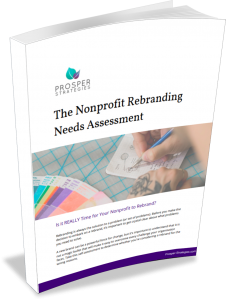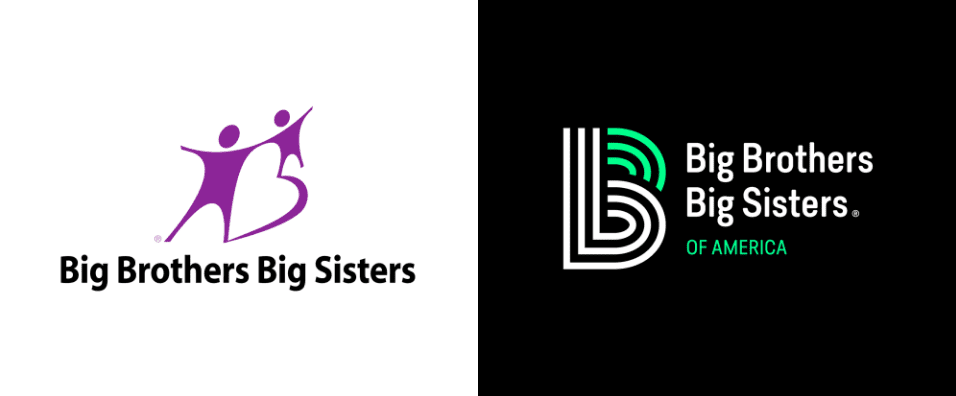The decision to rebrand mustn’t be taken lightly. And yet, every year, we receive inquiries from nonprofits that have committed to scrapping their current brands and building new ones without first doing due diligence to determine whether rebranding is truly the right move.
Jumping into a rebrand prematurely is a surefire way to waste time, energy and money, and doing so may hurt your nonprofit rather than help it.
So how can you determine whether it is REALLY time to rebrand your nonprofit? Begin by asking these questions.
Determine What Problem(s) You’re Trying to Solve
Rebranding is always the solution to a problem (or set of problems). Before you make the decision to embark on a rebrand, it’s important to get crystal clear about what problems you’re trying to solve.
[bctt tweet=”Before you make the decision to embark on a #rebrand, get crystal clear about what problems you’re trying to solve.” username=”ProsperStrat”]A new brand can be a powerful force for change, but it’s important to understand that it is not a magic bullet that will make it easy to overcome every challenge your organization faces.
Here are some common problems a nonprofit rebrand can solve:
- Lack of differentiation. If people often mistake your nonprofit for another organization, or worse, a government agency, a rebrand can definitely help.
- Misalignment between internal identity and your external image. If the way your organization shows up to the outside world hasn’t yet caught up with what your team believes and how your organization behaves internally, a rebrand can bring things back into sync.
- Unintentional stereotyping or disempowerment of stakeholders. If your name or brand labels the people you hope to help in a manner that actually harms their dignity, or in any manner that is misaligned with how they prefer to talk about themselves, a rebrand is likely advisable. Examples of organizations that have rebranded for this reason include NGLCC, formerly known as the National Gay & Lesbian Chamber of Commerce, and Resilience, formerly known as Rape Victim Advocates. Inclusion is also a key consideration here.
- Misalignment with changing organization strategy. The strategic planning process can trigger a rebrand when it results in the identification of a new strategy for your organization, especially when that new strategy involves broadening or narrowing the scope of your mission. It can take dozens or even hundreds of years for your organization’s mission and strategic focus to outgrow its brand, but at some point, it will happen. The renaming of YMCA (Young Men’s Christian Association) to The Y after 166 years is a perfect example.
- Lack of cohesion. If your stakeholders are communicating about your organization in a way that is totally inconsistent, or worse, inaccurate, a rebrand can be a great way to build cohesion. Fortunately, cohesion doesn’t have to mean depersonalization.
- Outdated image. One of the most common motivations for undertaking a nonprofit rebrand is the need for modernization. Some brands are more timeless than others, but when a brand becomes dated, it can be hard to ignore. Big Brothers Big Sisters is a perfect example, and one that shows an effective rebrand doesn’t have to include a new name.
And here are some problems that organizations convince themselves they can solve through a rebrand, even though they can’t:
- Internal conflict surrounding organizational strategy. Perhaps your board wants to steer your organization in one direction, and leadership wants to steer it in another. Maybe your staff disagrees with your leadership’s vision for your organization. Or perhaps your leadership team itself is divided and can’t come to agreement on your organization’s strategy, focus, or way forward. While these challenges are real (and common), a rebrand won’t be enough to solve them, at least not alone. An effective rebranding process always involves activities intended to hear the contrasting voices of internal stakeholders and find common ground, but if there are deep divisions in your organization in regards to your strategy and vision, you’d be wise to consider doing some work to build consensus or change course before engaging in a rebrand.
- Insufficient fundraising revenue. Yes, your brand plays an important role in a donor’s decision to give to your organization, but an effective brand alone won’t turn around a failing fundraising program. Rebrand if you must, but recognize you’ll need to follow your rebrand with the development and execution of effective marketing and fundraising strategies.
- Lack of visibility. In a similar vein, a new brand won’t necessarily make your organization more visible. Only an effective marketing and communications strategy can do that. What it can do is make your organization resonate on a higher level and appeal more effectively to your stakeholders, but you still have to show up in the right places, at the right times.
- Poor culture. A rebrand can give your staff something to be proud of and rally around. However, if your organizational culture is truly broken, even the most effective rebrand won’t reverse problems with retention, engagement and employee satisfaction.
How much brand equity do we stand to gain or lose?
A rebrand is always a financial risk, and that risk extends far beyond the cost of doing the work. All brands have equity, which is best explained as the financial value that derives from your stakeholders’ perception of your organization. An effective rebrand will result in improved brand equity, usually in a matter of months or a couple of years at most. An ineffective rebrand could cause your nonprofit to take a major step backward, and it may never recover.
Even if your current brand is weak, losing what little brand equity you do have could bring dire financial consequences. This doesn’t mean you should avoid change out of fear. It means you should make your risk a calculated one. Begin exploring the possibility of a rebrand through a brand equity study that assesses overall brand awareness and current brand perceptions, and then weigh the risk of rebranding against the risk of failing to do and against the opportunities a rebrand presents. If you hope to minimize risk, stakeholder testing of early stage brand concepts is also highly advisable. Don’t fool yourself into blindly believing that the internal consensus you and your consultants have built around your new brand will carry over to your external stakeholders.
Is our leadership, staff and board ready?
I’ve said it before but it bears repeating: nonprofit rebrands are far more likely to fail internally than externally. When a rebrand is forced upon internal stakeholders who are not properly prepared for change, the results can be disastrous. Before you begin any sort of brand work, take care to gather input from staff, board members and your entire leadership team about whether they feel a rebrand is necessary. The act of including them is as important as the input you’ll receive. Then, if you make the decision to move forward, take the time to properly educate your team about why you’re engaging in a rebrand, what the process will look like and how they (or others who represent them) will be included along the way. It may be worth revisiting the thoughts we shared earlier this year on the right (and wrong) way to engage your staff and board in a nonprofit rebrand.
Do we have the funds and time to do this work the right way?
An effective nonprofit rebrand is a significant investment, and in the long run, cutting corners will cost your organization more money than it saves. Costs and timelines vary significantly based on the complexity of the problems you’re trying to solve through a rebrand, the qualitative and quantitative research techniques required to solve those problems, and the size of your organization as it relates to the relative risk and opportunity associated with rebranding.
No two rebrands are exactly the same, which is why putting a rebranding project to RFP is rarely a wise decision. The rigid structure of an RFP process rarely allows for the substantive conversations a smart agency partner requires to accurately assess your needs the scope of their work. Rather than using your preconceived notions of what your rebrand should cost to create a request for proposal that aims to force fit agencies or consultants into a false budget, simply talk to potential partners about your challenges and what you’re looking to get out of a rebrand. Providing a rough sense of your financial situation and potential budget is typically helpful, but don’t get too specific. With enough deep discussion, a good agency partner will be able to help you understand the time and investment required for your unique situation. Then, you can determine if you have the funds and time to do the work the right way. If you don’t, it’s best to wait, save and prepare so that when you finally do take on a rebrand, you’ll be able to do it well.
Are you struggling to determine whether your organization should refresh or revamp its brand?
 Tell us about it. We can help you navigate this important decision, and if the way forward isn’t clear, we can guide you through the process of conducting a rebranding feasibility study. You can also download and complete our Nonprofit Rebranding Needs Assessment, a tool that will help you determine if you’re interested in a rebrand for the wrong reasons.
Tell us about it. We can help you navigate this important decision, and if the way forward isn’t clear, we can guide you through the process of conducting a rebranding feasibility study. You can also download and complete our Nonprofit Rebranding Needs Assessment, a tool that will help you determine if you’re interested in a rebrand for the wrong reasons.
